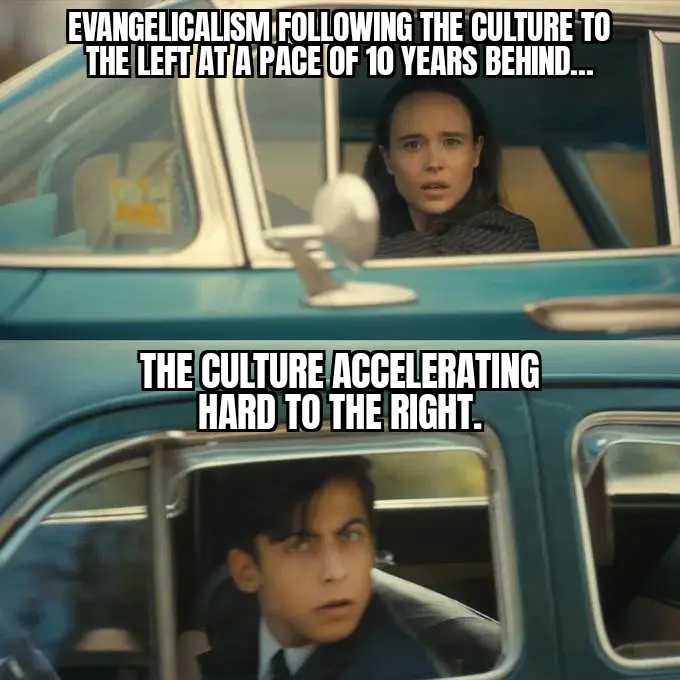
How Russell Moore, Beth Moore, J.D. Greear & others reversed the Conservative Resurgence.
Since the Evangelical Church trails the culture by 5-10 years, it explains why that the conservative surge in the culture is not yet reflected in the Southern Baptist Convention (SBC). In fact, the SBC is in the middle of an Obama-inspired Liberal Resurgence that significantly lags the rest of American society.
The Conservative Resurgence reflected the 1968 realignment heralded by Richard Nixon. Today’s Liberal Resurgence reflects the cultural trends since 2006 and accelerated by the Obama years.
It is an oft-told joke that Evangelicalism trails the culture by a decade. In other words, the trends in the secular world filter into the church’s practice about a decade after it has taken hold in popular culture. From music fads to leadership vision casting CEOs, what happens in the secular world finds its way into evangelical churches. We all know it is true. It is even a meme.
Thus, you see “Pronoun Hospitality” and the “Bible Whispers about Sexual Sin” sermons from SBC preachers like J.D. Greear. What you don’t see is the anti-Groomer pushback coming from conservative thought leaders like James Lindsay and Chris Rufo or support of anti-indoctrination laws enacted by Florida Governor Ron DeSantis. Instead of supporting the move rightward, the leaders of Big Eva (Evangelicalism) continue their work to move the church leftward. And this all boils down to timing.
The Conservative Resurgence was victorious beginning in 1979—a pivotal moment 11 years after the realigning election that made Richard Nixon President of the United States. Prior to that election, the New Deal Era social and economic policy ruled the land and especially elite thought.
As one writer described it, “Political junkies will be familiar with the traditional story of 1968: that it represented the end of the New Deal coalition and the post-war liberal consensus, and began the country’s political shift to the right. But 1968 was also a huge turning point for both parties.”
Naturally, the liberalism of the FDR era seeped into the broader culture. It dominated politics and influenced America’s ruling class. In time the secular liberalism influenced evangelical seminaries. While this alarmed conservatives, it took many years for it to reach a state where conservatives fought for control of the Southern Baptist Convention.
It was more than a decade after Nixon inaugurated the law-and-order realignment before conservatives won the first election to save the SBC from liberalism. Nixon’s realignment was precipitated by widespread social unrest—much like America has experienced since rioting during the Obama years. It seems reasonable to date the modern conservative revival to 2016 or perhaps even 2020 (despite Biden).
What explains the lag between cultural trends and evangelicalism? Perhaps it is that leadership reflecting a cultural shift takes time to come to power.
What explains this? Perhaps institutional inertia. Leaders from the previous alignment take power a few years after it gains widespread cultural influence and then it takes time for them to reveal their true intentions. It is about that time when the cultural shift is underway, and it takes some time for the pushback to infiltrate evangelicalism.
For example, Russell Moore was named president of the Ethics and Religious Liberty Commission (ERLC) of the Southern Baptist Convention on June 1, 2013. This was five years after Obama’s first election and almost a year after Obama’s reelection. It was in the swirl of talk about the Coalition of the Ascendant that would remake America into a leftist paradise.
Moore pushed the SBC to embrace the Coalition of the Ascendant. Something we’ve warned about since for years.
Everything going on within Evangelicalism boils down to Eva Elites convinced that their only way forward was to embrace leftist views on a range of issues and that would allow them to expand their brand with “People of Color.” If the price of building the brand was justifying voting for Democrats, then there were more than a few willing people in Evangelicalism in general and the Southern Baptist Convention in particular willing to do that. (For example, SBC President J.D. Greear said it is “great” if a Christian voted for a Democrat and Radical author and pastor David Platt wrote an entire book explaining why Christians opposed to abortion can still vote for Democrats.)
Overturning the Verdict of 1979: The Liberal Resurgence in the Southern Baptist Convention

Rarely do those pushing an organization leftward say out loud what they are doing. In the case of the recent firing of conservative professor David Allen, the goal was to punish a prominent conservative who helped conservatives triumph in the Conservative Resurgence.
David Allen was fired because not only was he friends with Conservative Resurgence architect Paige Patterson, but Dr. Allen pushed out former SWBTS President Russell Dilday—a supporter of the moderates who hated the so-called “fundamentalists” taking over the SBC. They cited Matthew 26:52 as justification. And to put a finer point on the matter when someone defended Dr. Allen, the tireless researcher explained that this person “voted with Coach Allen to fire Russell Dilday.”
Of course, bigger names are also saying the quiet part out loud about their love for the pre-Conserative Resurgence Southern Baptist Convention. Beth Moore famously tweeted an attacked the character of the people leading the SBC to defend the Bible from the attack of liberals.
Beth Moore said, “I don’t think it should be lost on any of us how suspect the character turned out to be in several of the key players who swung the SBC hard to the extreme right. I do not hesitate to say I don’t trust hyper fundamentalism as far as I can throw it. Lived too long. Seen too much. I’m referring to the CR.”
Not content with describing the Conservative Resurgence as “hyper-fundamentalism,” Beth Moore attacked the character of people in the movement.
Beth Moore said, “I wish to emphasize one additional thing. I believe there were some faithful SBC people who were gaslit & cast out in the 80s-90s for suggesting not everything about the Conservative Resurgence was of pure intent & that there were also serious political agendas within & without.”
Beth Moore once tweeted support (now deleted) for Roy Honeycutt. You can barely make out in that screenshot of Beth Moore’s tweet, the promotion of this book: Affirming Women in Ministry by radical egalitarian and theological “moderate” Roy L. Honeycutt. Beth Moore urged people to read Honeycutt’s work promoting women preachers. Honeycutt infamously called theological liberals to action with a “Holy War Sermon.”
Russell Moore, no relation to Beth Moore though they share the same leftist worldview, used a number of issues to push the SBC leftward. Racial Reconciliation being one of the most prominent. Moore was featured in the November 7, 2016, issue of The New Yorker and it was revealing. Moore talked about radical pro-abortion SBC leader Foy Valentine.
From the New Yorker, “A picture of Foy Valentine, daringly attired in a turquoise leisure suit, hangs on the wall outside Moore’s office, and his complicated legacy informs everything that the E.R.L.C. does today. ‘Courageous’ is not even a strong enough word for him—when it applies to civil rights,’ Moore says. The caveat is important, because Valentine’s political liberalism was not limited to matters of race. He was equally resolute in defense of abortion rights, even as most members of his church were starting to regard abortion as a national atrocity. In 1971, Valentine backed the denomination’s first resolution on abortion, which called upon Southern Baptists to support ‘legislation that will allow the possibility of abortion’ in a number of situations, as when the mother’s physical or emotional health was at risk.” (Emphasis mine.)
We’ve document how Moore’s purpose in the Southern Baptist Convention was two-fold: suppress conservative voters to ensure Democrats win elections and undermine biblical teachings to allow secular ideas influenced by Critical Race Theory (CRT), DEI, and more to remake how evangelicals think about political theology. Moore was an agent of infiltration that bragged about being a lifelong Democrat even while work at Albert Mohler’s Southern Baptist Theological Seminary (SBTS).
As Jack Richardson IV noted in October 2016, “It’s not so surprising that Russell Moore is a ‘Never Trumper,’ as he was always fond of reminding me that he was a Democrat.”
Historians of this period of the Southern Baptist Convention’s existence will spend time asking: How a lifelong Democrat who worked for a Democratic congressman became the chief conservative and mostly Republican voting SBC’s spokesman on political issues?
The answer: Networks.
It takes a Network to defeat a Network

General Stanley McChrystal said, “It takes a network to defeat a network.”
This maxim shows how leftists overcame the Conservative Resurgence. They exploited networks and ties with important evangelical parachurch organizations to establish their own reach within evangelical circles. Russell Moore (and others) exploited their ties with Albert Mohler (who championed them) to get not only the job leading the ERLC but prominent positions with groups like The Gospel Coalition (TGC).
While conservatives were unaware, Tim Keller and his ilk were building networks that would promote leftist ideology to scores of preachers and seminary students. Their reach was substantial. Also, while the leftist reach was increasing, conservatives sat idly and silently enjoying the fruits of the Conservative Resurgence in the Southern Baptist Convention. The response was disorganized and failed to fathom the extent of the leftist ideology at work until very late in the Liberal Resurgence. Much of the early efforts to resist focused on the Calvinist nature of the networks. It was only after the election of J.D. Greear that conservatives saw it was not Calvinism but something else—something far more sinister than a theological disagreement among orthodox Christians.
It was the election of J.D. Greear as President of the Southern Baptist Convention that highlighted how far Identity Politics and postmodernist deconstruction influenced SBC pastors.
Those researching this era should focus on how leftists exploited the Neo-Calvinist movement and associations. What made these movements so easy to infiltrate and so unaware of the dangers posed by leftist “Analytical Tools” like Critical Race Theory (CRT) and Intersectionality? Part of the answer no doubt resides in the celebrity culture that drives evangelicalism—this is likely a product of American consumerist culture; however, there are likely elements of this in how Christianity traditionally defers to those viewed as leaders because of the hierarchical nature of the Apostle’s teachings.
Conclusion: The Reactionary Phenomena
In the 1970s, Jerry Falwell wrote the Fundamentalist Phenomena—it outlined why mainline churches were collapsing and why conservative fundamentalist churches were booming. Falwell focused on the theological causes in his book. Falwell was right but only partially. The collapse of the mainline churches was a very specific issue of political theology—the practical teachings on the Vietnam War. The mainline churches were pacifist and anti-American. This drove away the people.
One scholar noted, “But, it was in the Vietnam era, when a large numbers of Protestant leaders actively campaigned against U.S. military policy, that for many churchgoers the opposition went too far. As Cambridge University historian Andrew Preston has written, ‘Divisions between liberal clerics and conservative congregants had always existed…but they were rarely as wide as on Vietnam.’”
Also, “Mainline Protestant denominations, however, did not fare as well. They went into decline, losing nearly one in six members between 1970 and 1985. In the same years, Evangelical churches grew by double-digit percentages. They welcomed Americans who had abandoned mainline denominations to protest the liberal views of clergy on many social issues, including the Vietnam War. These churches supported the religious right and its brand of conservative politics.”
It would be wrong to say this was only a political issue. It is both political and theological. The same as the issues in the church today. That is why there are exceptionally good theological arguments advanced against CRT, Queer Theory, and Neo-Marxism by many conservative Christians.
The ultimate outcome for all leftist churches is collapse. History proves this. What we are seeing now as conservative churches leave the SBC is very similar to the sorting of the 1970s. What remains to be seen is if the Conservative Baptist Network or other similar groups can harness the reactionary moment as the CR did in the late 1970s to retake the SBC from this Liberal Resurgence.
What can you do? You can learn how to fire your Woke Pastor. That is one great place to start.
Another is to decide if you want your church to remain in the SBC to fight to save it or leave it. This is a complex discussion that will vary by individual and by churches. Treating that is beyond the scope here. However, there are two points that you should consider.
First, if you are going to stay in the SBC then you must coordinate with others and make sure to send the maximum number of messengers. Otherwise, sending one or two messengers will continue to allow the SBC bureaucracy to dominate the Annual Meeting. Thus, to deal with the necessity of recruiting messengers, will require action to inform the church members of the dangers. You can do this by screening Enemies Within the Church and educating members during sermons about the leftward drift of the SBC.
Second, if you decide to leave the SBC, then one should not neglect the need for networks. Networks leverage the ability to make a difference. How networks are constructed are as variable as the imagination. However, it would be foolhardy to attempt to stand in isolation when the enemy is organized for action.
Graphic meme H/T Rett Copple.